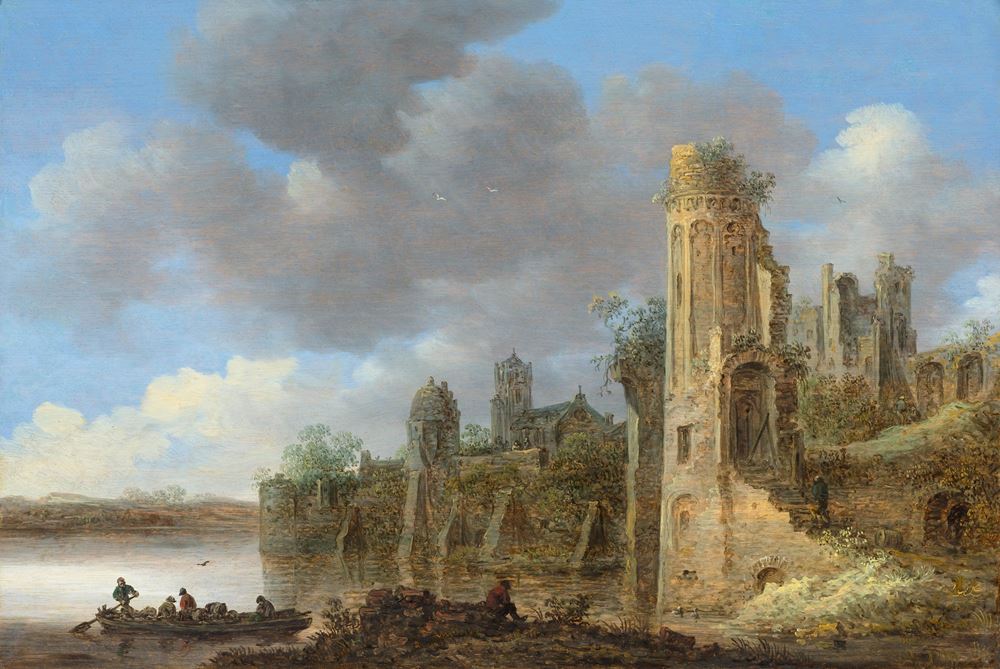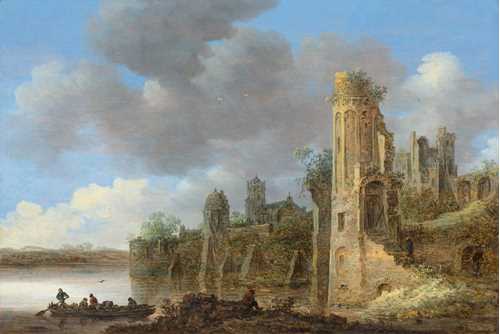
Lot 3053 - A192 Old Master Paintings - Friday, 19. June 2020, 02.00 PM
JAN VAN GOYEN
(Leiden 1596–1656 The Hague)
A ruined castle by a river.
Oil on canvas.
41 × 61 cm.
Expertise:
Dr. Hans Ulrich Beck, October 1962 (copy available).
Provenance:
- Art trade, Ch. Brunner, Paris, 1914, Cat.-No. 23, ill.
- probably collection of Linden 't Hooft, Holland.
- Goudstikker collection, Amsterdam, 1920, No. 735 (label verso).
- Collection of P. Smidt van Gelder, Nieuwersluis.
- Art trade, Jan Dik, Munich, 1962.
- Collection C. M., Zürich.
- Swiss private collection.
Exhibited:
- Amsterdam/Enschede/Rotterdam u.a. 1920, Galerie Goudstikker (Cat. XVIII, No. 15; Cat. XIX, No. 17; Cat. XX, No. 41).
Literature:
- Beeldende Kunst, VIII, 1921, No. 39, ill.
- Cornelis Hofstede de Groot: Beschreibendes und kritisches Verzeichnis der Werke der hervorragendsten Holländischen Maler des XVII. Jahrhunderts, 1907–1928, vol. VIII, Esslingen/Paris 1923, p. 207, No. 846 (with monogram and date 1648).
- Hans-Ulrich Beck: Jan van Goyen, 1596–1656, vol. II, Amsterdam 1973, p. 314, No. 688, ill. (with monogram and date: VG 1648).
- Wolfgang Stechow: Salomon van Ruisdael, Berlin 1975, p. 51.
This painting, recently uncovered in a Swiss private collection, of a river landscape with ruined castle, a subject which was taken up by Salomon Ruysdael (circa 1600–1670) as well as Van Goyen and which was presumably located in Gorinchem (also called Gorcum) (see Stechow 1975, p. 51), both for reasons of composition as well as painting technique, fits convincingly within the oeuvre of Jan van Goyen. The work bears witness to van Goyen’s mastery of the natural colour scheme of green, brown and yellow and his eschewal of hard contours. With his monochrome landscapes Jan van Goyen’s style contributed significantly to the realist approach to Dutch landscape painting and greatly influenced contemporaries, such as Salomon van Ruisdael and the young Aelbert Cuyp (1620–1691).
Born in Leiden, the son of a shoemaker, according to the Leiden chronicle of Jan Jansz. Orlers (1570–1646) the artist trained with the glass painters of the town, Coenraet van Schiperoort (1577–1636), Isaac van Swanenburgh (1537–1614), Cornelis Claesz. Clock (circa 1561–1629) and Jan Arentsz de Man (circa 1565–1625) and then in Hoorn with Willem Gerritsz. (circa 1582– circa 1628). After spending a year in France (1615–1616), van Goyen completed his education in the Haarlem studio of Esaias van de Velde (1587–1630). In 1618 he settled in Leiden and married Anna Willemsdr. van Raelst. In 1634 van Goyen moved permanently to The Hague, where he was accepted into the Guild of Saint Luke and was appointed head of the guild in 1638 and 1640.
Van Goyen specialised in the depiction of landscapes, in which he enlivened his motifs of villages, rivers, canals, beach and coastal scenes with simple rural figures engaged in everyday activities. From the 1620s onwards the artist focussed on diagonal compositions, incorporating architecture, landscape elements and figures. These included the recurring use of simple boats, often in the form of ferries full of passengers and loaded with cargo, which are set out as richly detailed genre scenes. As in the present painting, the figures served rather to suggest scale and less as part of a narrative.
Our thanks to Ellis Dullaart of RKD, The Hague, and Dr. Christiaan Vogelaar, who have confirmed the authenticity of this work on the basis of a photograph. They date the work to the 1640s when van Goyen produced a range of comparable compositions, characterised by a monochrome colour scheme (compare for example Beck 1973, No. 685, 686, 687 and 699), within which the impastoed style enlivens this fine work.
The painting is archived at the RKD, The Hague.
CHF 60 000 / 80 000 | (€ 61 860 / 82 470)
Sold for CHF 73 500 (including buyer’s premium)
All information is subject to change.


